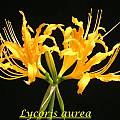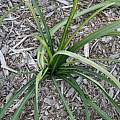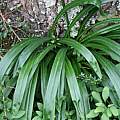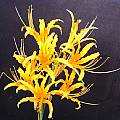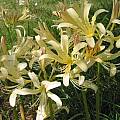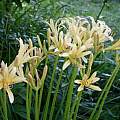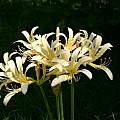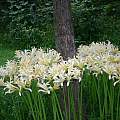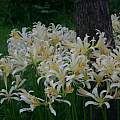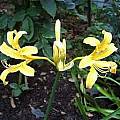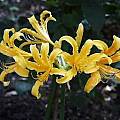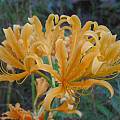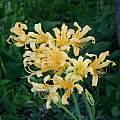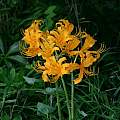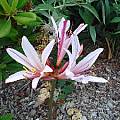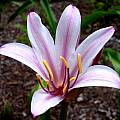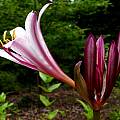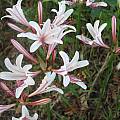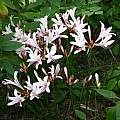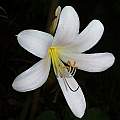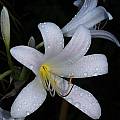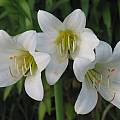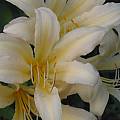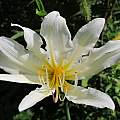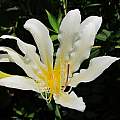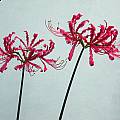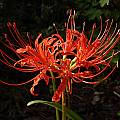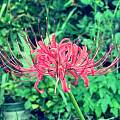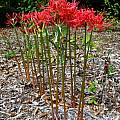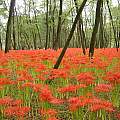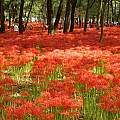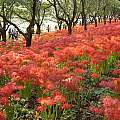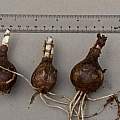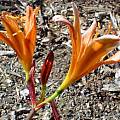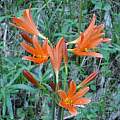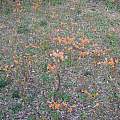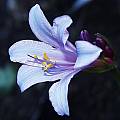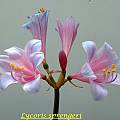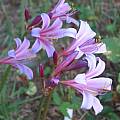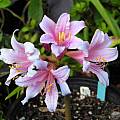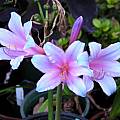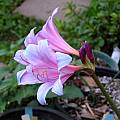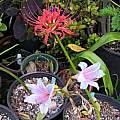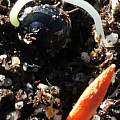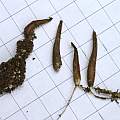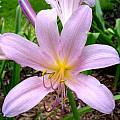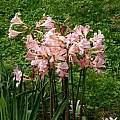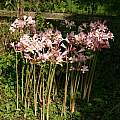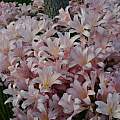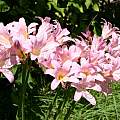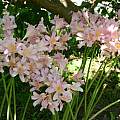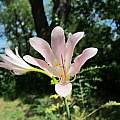Lycoris is a genus in the Amaryllidaceae family from eastern Asia, mainly China and Japan. They are dormant in summer, bloom in fall, and then grow in autumn, winter, and spring. Most grow best in the ground and they need summer warmth and some summer moisture to bloom well. Seeds are hard, black, and round. Seeds should be planted as fresh as possible (best planted immediately after harvest). Push the seeds down half-way into a moist planting medium. The seeds usually sprout quickly, but Sue Madison found that peeling off the black seed coat helps the seeds germinate. In colder areas with freezing temperatures, keep the seed pots in a cold frost-free greenhouse. Lycoris chinensis should germinate in spring. It is best to keep the seedlings in growth for as long as possible until they are large enough to be in their own pots. This can be accomplished by growing them indoors under lights. It takes a long time from seed to bloom, often as long as 5 years, so they are often propagated by division of the bulbs. Jim Waddick has provided a very complete guide to this genus called Garden Lycoris and More.
Lycoris Hybrids includes information and photos of some of the hybrids.
Lycoris aurea is the golden spider lily and originates from limestone areas of China. The spidery flowers face upwards and are a orange-cadmium yellow. It can often be a difficult species to get into flower. It requires a hot dry resting period during summer to promote flowering. Dressings of potash and lime are also helpful. Lycoris are splendid autumn-flowering bulbs when their requirements are met, and make excellent garden subjects and provide a good supply of cut flowers. Photo by Bill Dijk.
Photographs by Tony Avent who comments photo 1 is of our L. traubii foliage which is much narrower and emerges later than L. aurea shown in photo 2. The foliage of our L. aurea can be up to 2" wide and is the first to emerge and a very glossy green. Our L. aurea is also the only species that emerges with remnants of last years leaves on the sides of the flower stalk; a trait that reportedly distinguishes L. aurea from all other species.
Lycoris aurea var. surgens skipped blooming for a couple of years, then sent up two, much larger, scapes this year. It bloomed after all my other Lycoris bloomed. Photo taken October 2006 by Lee Poulsen.
Lycoris caldwellii known as Pale Yellow Surprise Lily has pastel yellow flowers that fade to near white. Although not common, this species is easy and hardy to Zone 5. This is a sterile triploid and probably originated as a natural hybrid in China. It is valuable for its pastel color, later bloom season, abundant flowers and impressive size. Photos by Jim Murrain and Jim Waddick showing flowers in various stages of bloom.
Lycoris chinensis known as the Golden Surprise Lily has medium yellow to golden-orange spidery flowers with curved and ruffled petal edges. It is native to China and is a fully fertile seed producing diploid that readily hybridizes with Lycoris longituba. It is hardy to Zone 5 and vigorous. Photos by Arnold Trachtenberg, Jim Murrain, and Jim Waddick. The last two show the variation in color, with one a rich yellow spidery form with twisted petals and the second near orange color with the color extending to the stamens.
Lycoris incarnata is sometimes called Peppermint Lycoris because it has red and white striped buds and flowers. Unlike many Lycoris, this one is reported to require a hot, dry resting period to flower well. It clumps up rapidly and produces dense displays of flowers. It is a good selection for northern gardens as it is hardy to Zone 5. Photos by Rob Hamilton, Jay Yourch, and Jim Murrain, and Jim Waddick. Notice the striped buds and pink midline on the inside and outside of the petals.
Lycoris longituba known as the White Spider Lily is a large handsome plant from China with the flower stems reaching to nearly 3 ft. The large regular lily-shaped flowers are variable in color and a pale yellow form (Lycoris longituba var. flava) has been named. Up to 15 different colors and forms from white to yellow to pink and median shades have been recognized in China. It is hardy to Zone 5, vigorous, and a fertile diploid readily producing seed and hybridizing with other fertile species. It is believed to be one of the parents of Lycoris squamigera. Photos by Arnold Trachtenberg and Jim Murrain.
These photos by Jim Waddick, show two different flowers from a single scape of Lycoris longituba. Normal flowers have 6 tepals, 6 stamens and a single stigma. This stem has flowers with 10 or 11 tepals and 9 or 10 stamens each. The single stigma seems unchanged. Normally Lycoris longituba is a fertile diploid species so these have been self pollinated in hopes of developing a multi-petal strain.
Lycoris radiata var. pumila is the red spider lily, and has much reflexed, recurved red flowers, wavy on the margins, with long, exerted filaments on tall, naked stems in late summer. Long-lasting and popular with the ladies in their floral art arrangements. Photo by Bill Dijk.
Lycoris radiata var. radiata This is the sterile triploid form, received from Jim Waddick, and common throughout much of the southern USA. Photo taken August 2004 by Lee Poulsen and September 2007 by Jay Yourch.
These photos of Lycoris radiata var. radiata were taken by Mari Kitama in the Kinchakuda and Gongendo parks in Japan in September 2010. Kinchakuda, a flat field surrounded by the Koma River was originally a natural habitat for this species. Many years ago people removed other plants so it would just display Lycoris radiata. It is estimated that there are now more than one million bulbs in this location. Gongendo was made as a bank to prevent from a flood of the Gongen river about 430 years ago. It was not a natural habitat for this species; they were planted starting about the year 2000.
Commercial Lycoris radiata bulbs, photographed by David Pilling.
Lycoris sanguinea is known as the Orange Surprise Lily. This is one of the smaller species and one of the most common of Japanese origin. Flowers are apricot to orange and it is one of the first to bloom. The var. kiusiana has larger flowers, but is otherwise similar to type.It is hardy to Zone 5. Photographed and grown by Rob Hamilton.
Lycoris sanguinea var. sanguinea, photographs from Japan by Mari Kitama.
Lycoris sprengeri known as the Small Pink or Electric Blue Surprise Lily is overall smaller in leaf and stem than many of the other species with stalks rarely exceeding 15 inches. Flowers are essentially pink, with pale blue tips, but variable with some a deeper pink and others almost entirely rich ‘electric’ blue. This is a fertile diploid that readily produces seed and is well suited to many garden locations as well due to more modest size. It is hardy to Zone 5. Photos by Arnold Trachtenberg, Bill Dijk, and Jim Murrain.
Here are photos of two separate scapes from the same bulb (from Jim Waddick) blooming once again in southern California, showing how the amount of blue can change from scape to scape. The first scape (first photo) bloomed when the temperatures were very hot, mid-to-high 90s F. (high 30s C.), and are more pink. The second scape (second and third photos), which bloomed when the temperatures were unusually low for August, upper 70s F. (mid 20s C.) are much more blue. The electric-blue buds are particularly spectacular. The last flower photo is of Lycoris sprengeri and Lycoris radiata blooming together, showing contrast between Lycoris flower form and color. Photos taken August 2004 by Lee Poulsen. In photo 5 a Lycoris sprengeri seed from Jim Waddick via PBS BX 297-4 is germinated by M. Gastil-Buhl, with toothpick in foreground included for scale. Photo 6 shows bulblets 2 cm long by 0.5 cm wide 7 months later in July.
Jim Waddick, Kelly Irvin, and Lee Poulsen contributed advice how to grow this cold-winter species L. sprengeri in zone 5-6, zone 6a/b, and zone 10a. All agree if grown in a container the depth must be that of a 2-gallon tree pot, 15 inches tall. Contrary to he normal growth pattern of winter dormancy and spring foliage expected for this species, Lee Poulsen has grown it successfully in a mild climate where it has altered its seasonal growth pattern, leafing out in mid-autumn and growing throughout the winter and spring and then going dormant in late spring. Even his grown from seeds follow this pattern. Then they bloom in August while dormant.
Lycoris squamigera is one of the most cold hardy. The flowers are pink with blue tips. The identity of this sterile hybrid (listed as a species) is controversial. Earlier works suggest that one of the parents is "L. straminea". What was known as L. straminea then is now called L. longituba. It may be a natural hybrid of L. sprengeri × L. chinensis. Experimental crosses between these two species also resulted in a hybrid that look to be L. squamigera. However, morphological characteristics point to a possible cross between L. longituba (2N) and L. sprengeri (N) to form a triploid hybrid.
Many people confuse Lycoris squamigera and Amaryllis belladonna because both bloom in the fall on bare stalks with no leaves, and both can have large pink flowers. You can see the differences on the Amaryllis belladonna versus Lycoris squamigera page.
Photos 1-2 taken July 2004 and August 2005 by Jay Yourch. Photos 3-5 were taken by Jim McKenney in a country garden he visited.
Photos below from Jim Waddick. The first show it surrounding a sweet gum tree. The second is a close up showing the hint of blue on petal tips. The last two show it blooming in sun and shade.
These photos by Jim Waddick show two different flowers that very closely resemble the common sterile triploid Lycoris squamigera, but there is no sign of blue tints in any part of the flower. All flowers on this stalk show this. It may be a similar hybrid. First seen in 2010, I have tried selfing it and crossing with typical Lycoris squamigera to see if it may produce seed one way or another.
